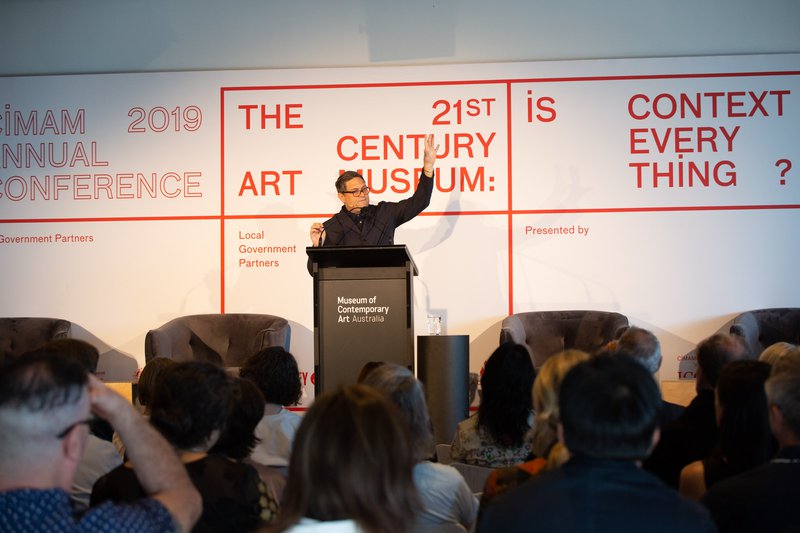Thorny questions prick complacency as conference tackles museum practice

Indigenous views and the quest for bigger collections were on the meeting’s agenda
Written by Elizabeth Ann Macgregor and published originally by The Australian, 4 December 2019
A few weeks ago, more than 200 curators and directors gathered at the Museum of Contemporary Art in Sydney for the annual conference of the International Committee for Museums and Collections of Modern Art.
Known as CIMAM, this group is part of the International Council of Museums, whose president, Suay Aksoy, contributed to discussing the most pressing topics for our sector today.
Aksoy’s visit came in the wake of a recent ICOM meeting in Japan where a proposal for an updated definition of museums caused intense debate. That definition remains unresolved. The topic of the Sydney conference — museums and their context — was highly pertinent to this debate, and Aksoy urged delegates to share their thoughts.

The first day, which focused on how museums relate to first peoples, opened with a stirring keynote by Wesley Enoch, a proud Noonuccal Nuugi man and artistic director of the Sydney Festival. His provocation was that objects, which for so long have been at the heart of the museum, are for First Nations simply detritus — the end result of a process of storytelling and ceremony, the product of people coming together to share experiences. Enoch was not suggesting that museums should rid themselves of objects: instead they should consider redefining themselves according to indigenous principles, with people at the centre.
His presentation was followed by two case studies: one from Wanda Nanibush, curator of indigenous art at the Art Gallery of Ontario, and the other from Honolulu-based independent curator Ngahiraka Mason. Moderated by Stephen Gilchrist, the three speakers discussed how museums everywhere could learn from indigenous perspectives.

The second day was no less challenging. Keynote speaker Franklin Sirmans, director of Miami’s Perez Art Museum and one of the world’s few African-American museum directors, questioned the incessant quest to build ever larger collections requiring larger buildings and storage facilities. Opened in 1984, the Perez has about 4000 works of art, and Sirmans raised the contentious issue of deaccessioning to make collections more relevant to communities.
Subsequent case studies by Maori artist Lisa Reihana, who addressed the changing nature of technology, and Hannah Mathews, who looked at how museums can collect ephemeral material such as performance, demonstrated the need to accommodate the range of contemporary practice. The reminder that art is often a process as much as a product resonated strongly with Enoch’s initial provocation.

Day three took up Enoch’s challenge with a keynote by Sally Tallant, recently appointed executive director of New York’s Queens Museum and previously director of the Liverpool Biennale. Tallant is rethinking the strategic planning models that start with the museum and its collections. She proposes a new vision for the Queens Museum that has the community, or rather communities, at the centre.
MCA senior curator C3West Anne Loxley and Kuku Yalanji artist Tony Albert presented Remembering and Healing: the Blacktown Native Institution, a collaboration with Blacktown Arts Centre, a moving account of how art can help deal with complex and traumatic histories, bringing about resolution and, in this case, the historic handing back of the site to the Darug people.
Lara Strongman, former head curator at Christchurch Art Gallery Gallery, told how the gallery had brought art back to the community after the 2001 earthquake. For nearly five years the gallery had not been able to operate in its building, hence an innovative program running art throughout the city, demonstrating the role that art and artists could play in bringing people together even in the most difficult circumstances.
These sessions were interspersed with workshops on topics including censorship and populism, and digital disruption. Delegates also visited venues across Sydney and Brisbane before a final tour of Minjerribah, Stradbroke Island, the land of Enoch’s people.
The strong focus on indigenous perspectives demonstrated how the world of museums could learn from listening to first peoples. Some participants were calling for a radical rethink of museum practice in a time of global strife, community polarisation and climate emergency. Should we continue to expand? Are the days of touring blockbusters over? How much do arts professionals need to travel do to undertake their jobs?
The ICOM network provides a space to share experiences and support each other in time of difficulties. As I step down as CIMAM president, I believe even more strongly that museums, especially those that engage with contemporary artists, have a vital role in public discourse. Our acknowledgment of country pays tribute not just to elders past and present but future. What kind of future can museums help to create?
Elizabeth Ann Macgregor is director of the Museum of Contemporary Art and outgoing president of the International Committee for Museums and Collections of Modern Art.